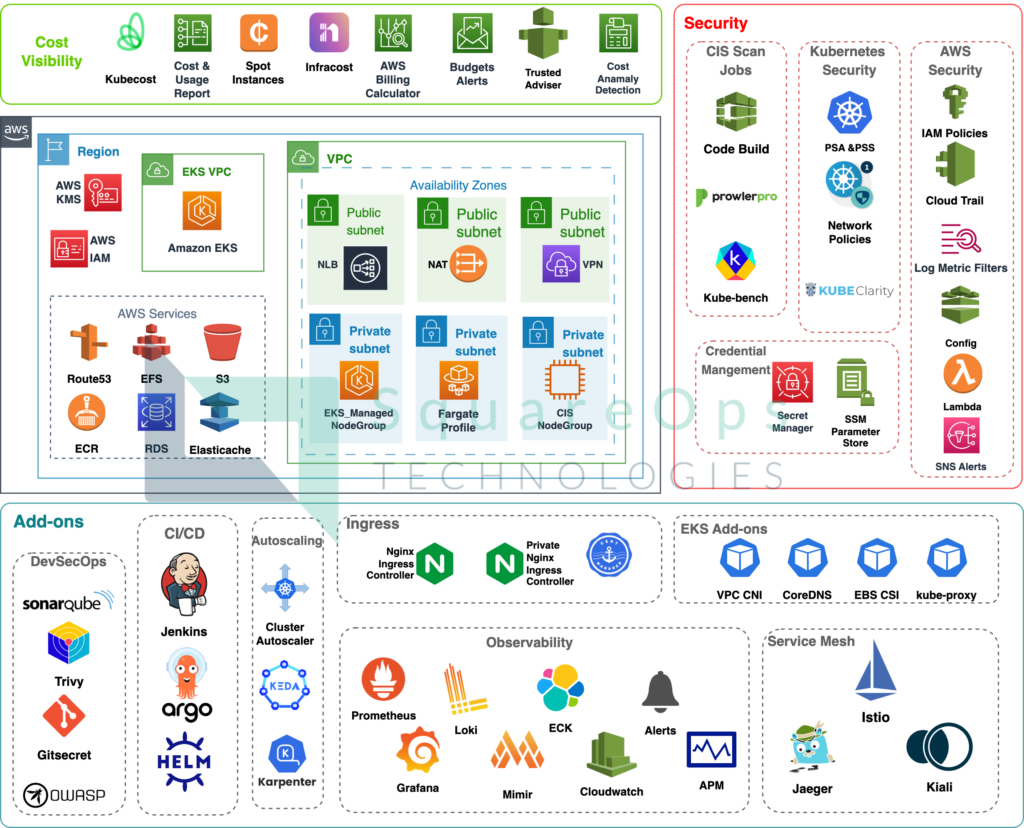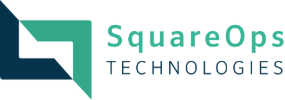How to Accelerate Kubernetes Adoption with SquareOps Automation
We are an AWS Advanced Consulting Partner and are delighted to present our SquareOps Kubernetes Adoption Framework (SKAF), a premier solution for seamless, efficient, and adaptable Managed Kubernetes service, amplified by our AWS EKS Service Delivery Badge. This reflects our top-tier proficiency in Kubernetes Deployment, meeting the highest standards across providers like EKS, GKE & AKS.
SKAF is a harmonious fusion of industry-leading tools and methodologies, meticulously crafted to offer a solid foundation for Kubernetes application deployment on various platforms. Our foremost goal is to empower you to focus on creating solutions and products while we manage system observability, security, and infrastructure management with our experienced team.
Key Features:
- Security : Secure at every aspect of cloud infrastructure, Kubernetes, and workloads. Includes DevSecOps in ci/cd pipelines. CIS and SOC-2 compliant deployments
- Monitoring and Observability : An ecosystem of workload metrics monitoring, logs monitoring, APM, and tracing with alerts to your convenient destination - Email, Slack, or Teams
- Deployment Readiness : A suite of terraform modules library, architecture blueprints, and deployment templates Enhanced reliability with automated infrastructure deployment pipelines and change management

What SquareOps Managed Kubernetes Automation Offer's
DevSecOps Lifecycle
- Secure VPN Connectivity via Pritunl: Ensuring robust network security.
- VPC Peering: Secure and private connectivity between VPCs.
- Network Segmentation: Security isolation by placing applications and databases in separate subnets.
- CIS Compliance for Network and EKS: Adherence to industry-standard security practices.
- Data Encryption at-rest and in-transit: Using AWS KMS and end-to-end TLS for data protection.
- Static Application Security Testing (SAST): Early detection of application vulnerabilities.
- Image and Credentials Scanning: Incorporating DevSecOps practices for CI/CD pipeline security.
- Vulnerability scanning with Kubeclarity: Regular image scanning inside the cluster for security.
- CIS Scanner Pipeline, Prowler, KubeScan, Kube bench: Continuous security checks for EKS Cluster and AWS resources.
- Pod Security Policies and Namespace Isolation: Additional layers of Kubernetes security.
- Web Application Firewall (WAF): Protection for web applications from common web exploits.
- Role-Based Access Control (RBAC): Managing access to Kubernetes resources.
Monitoring and Observability
- VPC Flow Logs: In-depth visibility into network traffic.
- Cluster Autoscaler and Karpenter: Monitoring and managing resource scaling.
- Highly available Prometheus and Grafana: Comprehensive monitoring of Kubernetes cluster, application workloads, and self-managed services.
- Loki integration with Grafana: Consolidated log monitoring for clusters and application management.
- Grafana and Slack: Real-time alerting for efficient issue detection and resolution.
- Elastic Cloud for Kubernetes with APM: Monitoring and tracing for better application performance.
- Elasticsearch Alerts: Proactive alerting for issue resolution.
- Cloudwatch logs and dashboards: Monitoring AWS managed services.
- Endpoint Monitoring: Monitoring the performance of network endpoints.
- Service Mesh : Gain insights through inbuilt tracing, monitoring, and logging.
- Service Mesh : Enhance secure service-to-service communication with mTLS.
Deployment Readiness
- Multi-account/region networks: Readiness for diverse and global deployments.
- AWS Remote State Management: Automated and reliable infrastructure deployment pipelines.
- Helm and EFS Storage Class: Efficient application deployment templates.
- Comprehensive Documentation: Product guides, deployment best practices, and release management for optimal reliability.
- Fine-grained IAM permissions and Module Registry: Terraform module libraries for rapid, scalable, and reliable deployments.
- Horizontal and Vertical Pod Autoscaling: Resource management and cost optimization.
- Keda Scaling: Efficient vertical pod autoscaling.
- Istio service mesh: Managing network traffic and microservice communication.
- Chaos Testing and Load Testing: Ensuring system resilience and performance.
- Backup and Disaster Recovery: Protecting data and ensuring system uptime.
Benefits for your business
High Level Architecture of SquareOps Kubernetes Automation

Different Use-Cases
01.
Microservice Delivery
The SquareOps Managed Kubernetes Automation serves as an ideal platform for the delivery of microservices. With its integrated toolset and focus on infrastructure automation, it significantly reduces the complexities of deploying, scaling, and managing microservices.
By leveraging industry-standard tools such as Helm, Istio, and Karpenter, the framework ensures efficient application packaging, secure service-to-service communication, and resource optimization. In addition, built-in observability tools such as Prometheus, Grafana, and Loki provide end-to-end visibility into application performance and logs, enabling real-time alerting and faster issue resolution. This, combined with robust security measures and practices, makes SKAF a reliable partner for microservice delivery.
02.
Multi-Tenant SaaS Delivery
For organizations delivering multi-tenant SaaS applications, SquareOps Managed Kubernetes Automation offers a powerful set of features to ensure scalability, isolation, and performance. By supporting the deployment of Kubernetes across multiple accounts, regions, and subnets provides an infrastructure that can scale with your SaaS business while maintaining strict isolation between tenants for enhanced security.
The Automation’s built-in support for advanced security features such as data encryption, CIS compliance, and role-based access control ensures your SaaS application is secure at all times. Furthermore, with its integrated monitoring and observability stack, you can gain insights into tenant usage, performance metrics, and application logs, enabling proactive issue detection and superior tenant experience.
03.
Multi-Account and Multi-Region Deployments
SquareOps Managed Kubernetes Automation shines in scenarios that require multi-account and multi-region deployments. Its robust architecture supports a broad range of deployment topologies, catering to the needs of enterprises operating in diverse geographical locations and regulatory environments. With SquareOps Managed Kubernetes Automation, you can achieve seamless and secure networking across accounts and regions, thanks to features like VPC Peering and secure VPN connectivity. The framework also provides advanced cost management capabilities, with the ability to report costs based on environment and resource tags. Moreover, the framework’s commitment to minimising vendor lock-in empowers you with the flexibility to adapt to the changing needs of your business without worrying about migration hassles
04.
Cloud Agnostic Deployments
In an era where flexibility and adaptability are key, SquareOps Managed Kubernetes Automation offers a comprehensive solution for cloud-agnostic deployments. By leveraging its unique blend of industry-standard tools and methodologies, it allows you to build infrastructure that’s not only robust and scalable but also free from the constraints of vendor lock-in. Whether you aim to migrate to a different cloud provider, extend your operations into a hybrid multi-cloud approach, or maintain resilience against cloud provider-specific outages, SKAF ensures your transition is seamless and efficient.
The Automation’s commitment to Terraform and Helm as infrastructure and application deployment tools ensures your configurations are expressible in a provider-agnostic way, simplifying migrations. Meanwhile, the use of platform-independent services like MySQL, Redis, MongoDB, and RabbitMQ for self-managed services further reinforces the cloud-agnostic approach. This flexibility paired with robust security, monitoring, and cost management features makes it an ideal choice for organizations seeking a future-proof solution for their cloud infrastructure needs.

